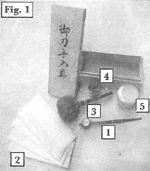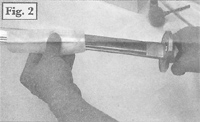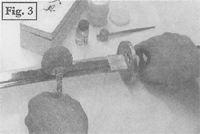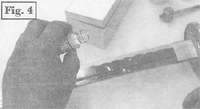

|
Blade
Types Shop
By Steel Steel
Types
Misc Items About
Us |
The composition of carbon steel katanas makes it very susceptible to rusting. In fact, sometime it is the simplest factor that you can use to determine that your sword is genuine carbon steel. The proper care and maintenance of swords is critical if they are to retain their condition. CARE: Critical! Do not subject or leave your sword in high temperature areas or in direct sunlight. The wood on your saya can absorb moisture from the environment or from sheathing of a blade immediately after cutting. The trapped moisture may be released when the saya is subjected to high temperature and end up on your blade. Leaving a sheathed blade in sunlight or elevated temperature can quickly stain and rust the steel. Keep a light coat of oil on your blade when not in use. A heavier and more viscus coat may be necessary for long term storage. When handling the sword, try not to touch the blade surfaces with your bare hands or other wet or moist materials (especially if its acidic). If done, please clean and re-oil your blades immediately. When storing the blade in its scabbard, spraying some water displacement solutions (WD 40) into the scabbard to remove any moisture on the inner surfaces of the scabbard. Then store the blade in a cool, dry place out of direct sunlight. Regular Maintanence: A sword cleaning kit is absolutely necessary for the maintenance of your katana. If you do not own one, make sure you get one as soon as possible.
Before you begin - Caution: The blade of your katana is extremely sharp and may cause serious injury. Make sure that the blade edge is never in a position where it could injure yourself or others. Maintaining your Katana: The scabbard of your katana is finished in many coats of black lacquer. To preserve the sheen, the scabbard needs only to be wiped occasionally with a very soft cloth. Handle the scabbard only by holding the wrapped section; otherwise fine scratches caused by handling the lacquered sections will dull the finish. Blade Maintenance:
Apply a few drops of oil along the length of each side of the blade and use a piece of rice paper or cotton cloth to spread the oil evenly over the blade. Be sure not to touch the blade again before resheathing. Stain Removal/Polishing: 1. Stain Removal - Should your sword be stained or show beginning signs of rusting, there are a few things you can do to restore the condition of your blade to its original. If the stains are light, try using a pencil eraser to see if the stains can be removed. This only works for very very light stainings. For heavier stains, you will need to use wet sandpaper between 600 and 900 grit (depending on the particular blade) to take off the staining. Sand it wet and parallel to the blade until the stains have disappeared, then dry thoroughly and re-oil immediately. Should the blade become so corroded that 600-900 grit sandpaper does not work, your blade probably have developed some pitting. Most minor pittings only effect the blade cosmetically, should the pitting be extensive, you may want to consider retiring the blade and find a replacement. (Our sword are priced so that it is often better to simply replace the blade rather than to try to restore it). 2. Polishing - If you want to give your blade a higher level of polish, there are several things that you can do and several that you should not do. DO NOT USE A MECHNICAL BUFFING WHEEL - Though this may seem like a quick and simple solution, the cutting edge and niku of the blade can be adversely effected by machine buffing. At minimum, you will take away some material on the cutting edge and dull the blade.... It may not be noticable initially, but it will reduce the cutting ability of your sword. (You will start to notice when your rate of successful cuts diminish. We recommend a hybrid polish if you absolutely must repolish your sword. This is done by using progressively finer and finer sandpaper (starting from about 900 grit to 1500 grit), wet sanded parallel to the blade on the MUNE of the sword ONLY. Then finally finishing off with light hand buffing using a compound such as Metal-Glo. (PLEASE NOTE: INSPECT YOUR SWORD THOROUGHLY BEFORE YOU BEGIN POLISHING YOUR BLADE. YOU WILL NOT BE ABLE TO, SHOULD YOU NEED TO RETURN OR EXCHANGE YOUR SWORD FOR ANY REASONS. A RE-FINISHED BLADE CANNOT BE RETURNED OR EXCHANGED). |
||
|
|
|||

 Our
sword maintenance kit includes the following which is necessary
in the proper care of your katana:
Our
sword maintenance kit includes the following which is necessary
in the proper care of your katana: First,
use a sheet of rice paper to remove oil from previous maintenance,
holding the edge away from you and working very carefully to avoid
injury. (Note: if you wish to save the rice paper, a soft cotton
cloth may be substituted).
First,
use a sheet of rice paper to remove oil from previous maintenance,
holding the edge away from you and working very carefully to avoid
injury. (Note: if you wish to save the rice paper, a soft cotton
cloth may be substituted). Then
tap the powder ball lightly against the blade every two inches or
so along its length, dusting the blade very lightly with powder.
(Note: when using the ball for the first time. You may need to tap
the ball against the blade a few times to "start" the
powder flow through the fabric of the ball.) Then use a clean piece
of rice paper or cotton cloth to carefully rub over the powder to
polish the blade. Repeat until both sides of the blade have been
polished and the powder is removed. Do not inhale the powder.
Then
tap the powder ball lightly against the blade every two inches or
so along its length, dusting the blade very lightly with powder.
(Note: when using the ball for the first time. You may need to tap
the ball against the blade a few times to "start" the
powder flow through the fabric of the ball.) Then use a clean piece
of rice paper or cotton cloth to carefully rub over the powder to
polish the blade. Repeat until both sides of the blade have been
polished and the powder is removed. Do not inhale the powder.  (If
oil and powder is not enough to remove debries adhered to the blade,
you can use a paper towel wetted with either water or solvents to
clean the blade surface. thoroughly dry, and repeat the maintanence
process from the beginning).
(If
oil and powder is not enough to remove debries adhered to the blade,
you can use a paper towel wetted with either water or solvents to
clean the blade surface. thoroughly dry, and repeat the maintanence
process from the beginning).
